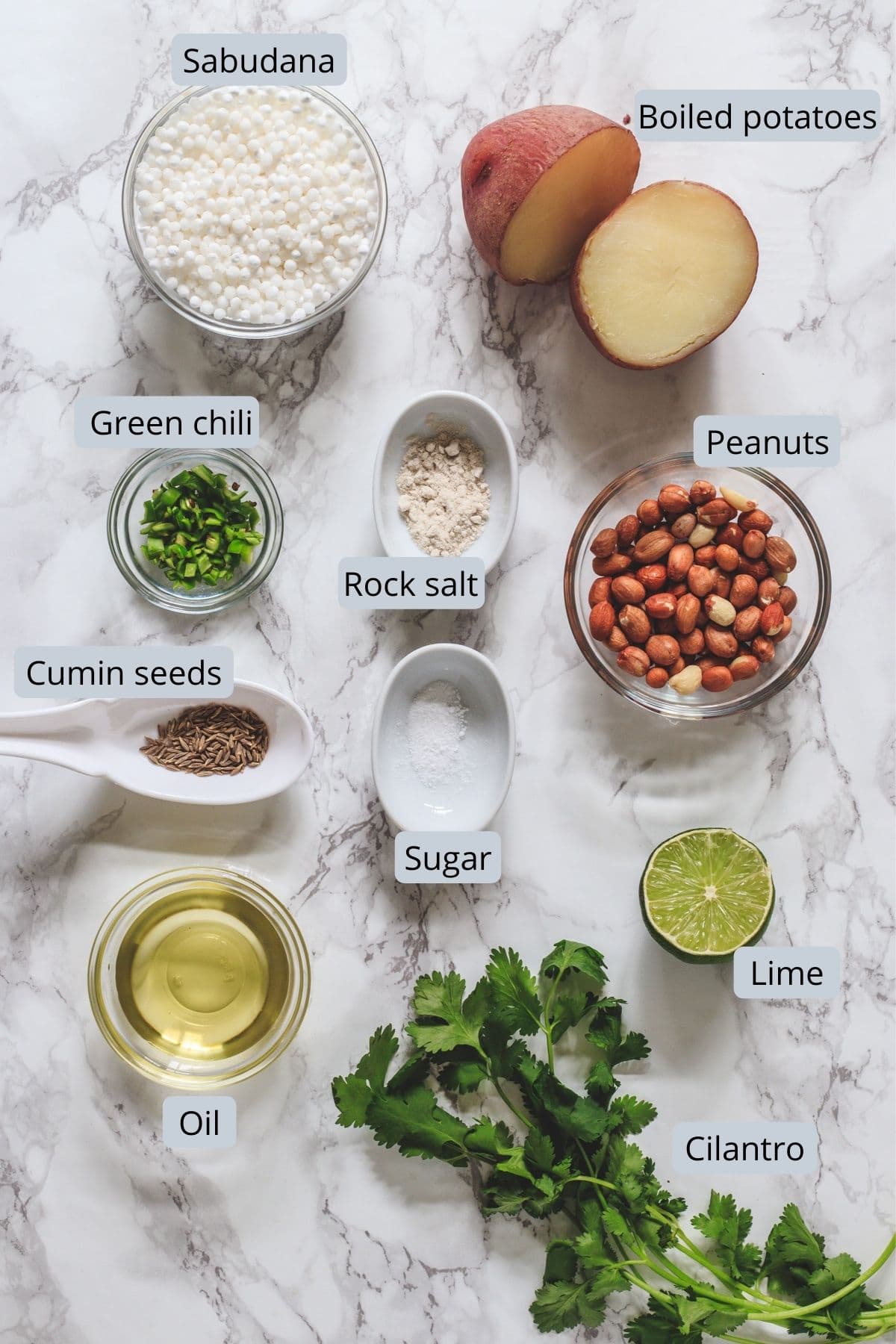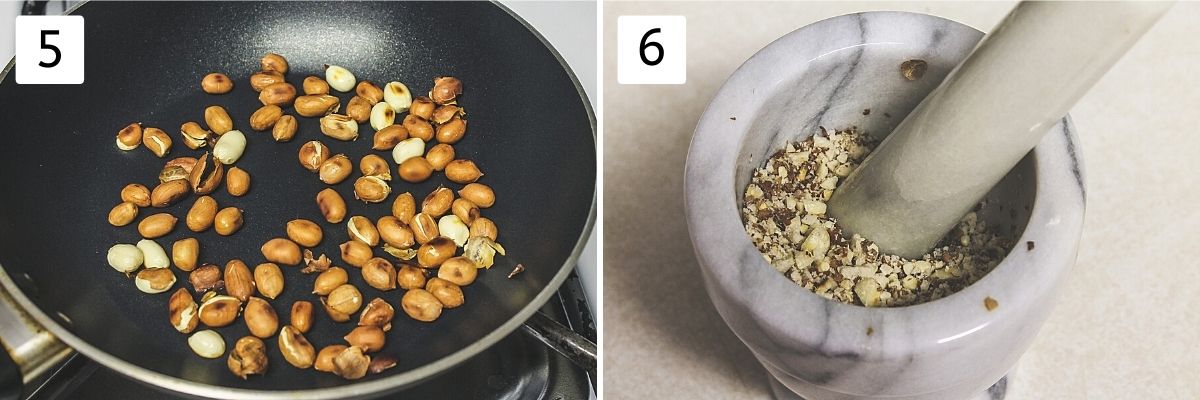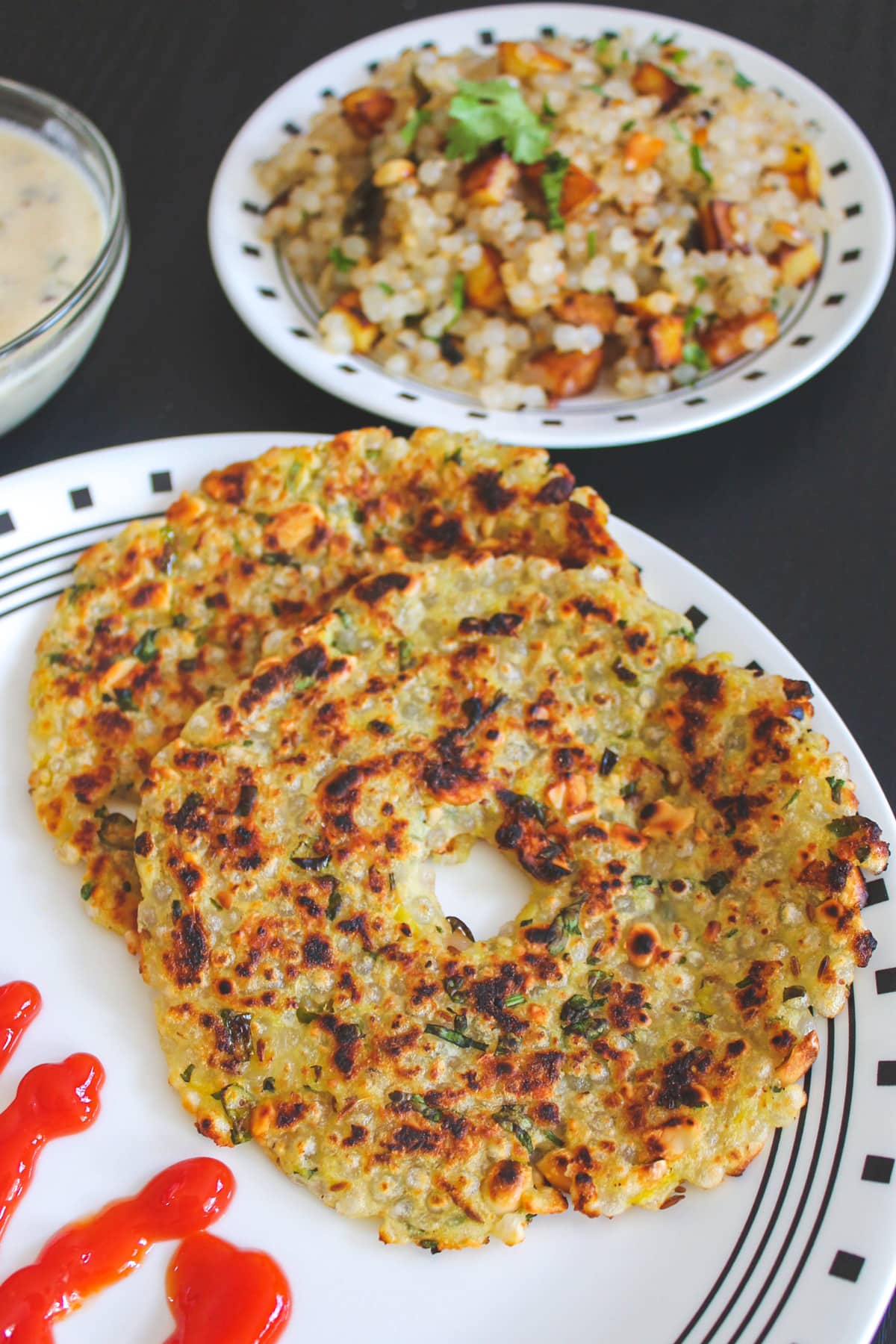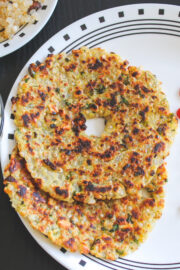Sabudana thalipeeth - all the delicious flavors of sabudana vada shaped into the thalipeeth (flatbread) form. This is the popular Maharashtrian snack recipe made during Hindu fasting like Navratri vrat.
It is also known as upasache thalipeeth or farali thalipeeth.

Jump to:
❤️ You’ll Love This Sabudana Thalipeeth
It is made from tapioca pearls. They are soaked and drained well. Then boiled mashed potato is added. Also, crushed peanuts and few spices are added. Then rolled into a circle and shallow fried on tawa. It is that simple to make.
Do you like sabudana vada? If yes, then you’ll sure like this sabudana thalipeeth.
The thalipeeth mixture is almost the same as vada but the texture is different here.
Not only during vrat or upvas, but this can also be made and enjoyed on a regular day as breakfast.
It is healthy, delicious and makes a very filling meal.
🧾 Ingredient Notes
Here is the pic of the ingredients used in making sabudana thalipeeth.

- Sabudana: It is also known as sago or tapioca pearls. This is allowed during fasting or vrat. You need to soak it a few hours or overnight.
- Boiled potatoes: these are mashed and used in the recipe and it acts as a binding agent. I recommend using red potatoes or Yukon gold potatoes.
- Rock salt: Since regular table salt is not allowed during vrat, rock salt (aka sendha namak) is used here. If making on regular days, you can use regular salt.
- Peanuts: They are roasted and coarsely ground. It adds a nice crunch. To achieve this texture, do not make it powder instead keep it coarse.
- Lime: You can use lemon juice as well. It adds a nice tang to the dish and balances all the flavors.
- Green chilies: This is the only ingredient that gives a hot and spicy taste. So increase or decrease as per your liking spice level.
👩🍳 How To Make Sabudana Thalipeeth? (Pics)
Preparation:
1) Take sabudana in a colander and wash under running cold water. Make sure to remove all the starch by rubbing the pearls between fingers and thumb. Then soak in the water for 3-4 hours or overnight. (depending on the type and quality of the sabudana, soaking time may vary.) the one we get here in the USA always requires overnight soaking.
2) After the soaking time, you’ll notice all the water is absorbed by the pearls and there is not any water left.
3) But just to make sure, drain the excess water by transferring the sabudana into the colander and rest for 15-20 minutes. It is important to get rid of the moisture otherwise thalipeeth mixture becomes sticky and loose, so it gives a hard time shaping them.
4) Let’s check sabudana if it is soaked properly or not. When you press one soaked pearl between your finger and thumb, it should mash very easily without any effort.

5) While sabudana is draining, dry roast the peanuts in a pan on medium heat with stirring constantly until they become golden brown.
6) Let it cool down and roughly crush them using mortar and pestle. Alternatively, you can coarsely ground using a food processor.

Making Sabudana Thalipeeth:
1) Take all the ingredients in a bowl.
2) Mix them well and make a dough-like ball. If it is too loose and sticky then you can add any fasting flour (rajgira flour or Singhara flour or sama flour).

3) Divide it into 8 equal parts. And make a smooth ball using your palms. Take a piece of aluminum foil or plastic, grease it with oil and put that ball on top of it. And also heat the pan on medium heat for pan-frying the thalipeeth.
4) While the pan is heating, make 4-inch diameter thalipeeth by pressing the ball with your hand. Keep sealing the edges as you press if it breaks. And also make about the quarter-inch hole in the center with the help of your finger.
5) Once the pan is hot, drizzle some oil in the pan. Carefully take thalipeeth in your hand with the help of foil and put it in the pan.
6) Let it brown on the bottom side, drizzle some more oil on top and then flip it. Also, cook on another side till it becomes golden brown.

💭 Expert Tips
Soak the sabudana well. Check by pressing a pearl and it should mash easily. If not then you’ll taste the raw, chewy sabudana in the thalipeeth.
The moisture content: If the mixture is too moist then it becomes sticky and unable to shape. To avoid that drain the sabudana really well. Plus, make sure not to use over-boiled potatoes (which as too much moisture in them).
By any chance, if the mixture becomes loose and sticky, then add a couple of tablespoons of rajgira atta or singhara atta and mix. Repeat until the mixture becomes pliable, non-sticky and shapable.
If sabudana thalipeeth breaks while shaping - meaning the mixture is too dry. Sprinkle little water and mix. Try shaping again, it should work.
🍽 Serving Ideas For Sabudana Thalipeeth
- If making this on vrat, serve with vrat wale aloo or dahi aloo. It will make the filling meal.
- You can serve this sabudana thalipeeth with farali kadhi or farali chutney.
- Here in the photo, you can see I have served with ketchup because I made this on a regular day. Ketchup is not considered as fasting food.

Check Out More Sabudana Recipes
PS Tried this recipe? Please leave a star rating in the recipe card below and/or a review in the comment section. I always appreciate your feedback! Plus, Subscribe to my newsletter and follow along on Pinterest, Instagram, and Facebook for all the latest updates.
Recipe Card
Sabudana Thalipeeth Recipe
Ingredients
- 1 cup Sabudana (Sago or Tapioca pearls)
- 1 ½ cup Potatoes tightly packed, boiled, peeled and mashed
- ½ cup Peanuts Roasted and Roughly crushed
- 2 Green chilies chopped finely
- 4 tablespoons Cilantro or coriander leaves chopped
- 2 teaspoon Cumin seeds
- 3 teaspoons Lemon juice Or Lime juice
- 1 teaspoon Sugar
- Rock salt (Sendha namak) to taste
- Peanut oil to cook the thalipeeth
Instructions
Prep & Soaking Sabudana:
- Take sabudana in a colander and wash under running cold water. Make sure to remove all the starch by rubbing the pearls between fingers and thumb.
- Then soak in the water for 3-4 hours or overnight. (depending on the type and quality of the sabudana, soaking time may vary.) the one we get here in the USA always requires overnight soaking.
- Drain the excess water by transferring the sabudana into the colander and rest for 15-20 minutes. It is important to get rid of the moisture otherwise thalipeeth mixture becomes sticky and loose, so it gives a hard time shaping them.
- Let’s check sabudana if it is soaked properly or not. When you press one soaked pearl between your finger and thumb, it should mash very easily without any effort.
- While sabudana is draining, dry roast the peanuts in a pan on medium heat with stirring constantly until they become golden brown.
- Let it cool down and roughly crush them using mortar and pestle. Alternatively, you can coarsely ground using a food processor.
Making Sabudana Thalipeeth Recipe:
- Take all the ingredients in a bowl.
- Mix them well and make a dough-like ball. If it is too loose and sticky then you can add any fasting flour (rajgira flour or Singhara flour or sama flour).
- Divide it into 8 equal parts. And make a smooth ball using your palms. Take a piece of aluminum foil or plastic, grease it with oil and put that ball on top of it. And also heat the pan on medium heat for pan-frying the thalipeeth.
- While the pan is heating, make 4-inch diameter thalipeeth by pressing the ball with your hand. Keep sealing the edges as you press if it breaks. And also make about the quarter-inch hole in the center with the help of your finger.
- Once the pan is hot, drizzle some oil in the pan. Carefully take thalipeeth in your hand with the help of foil and put it in the pan.
- Let it brown on the bottom side, drizzle some more oil on top and then flip it. Also, cook on another side till it becomes golden brown.
Notes
- Soak the sabudana well. Check by pressing a pearl and it should mash easily. If not then you’ll taste the raw, chewy sabudana in the thalipeeth.
- The moisture content: If the mixture is too moist then it becomes sticky and unable to shape. To avoid that drain the sabudana really well. Plus, make sure not to use over-boiled potatoes (which as too much moisture in them).
- By any chance, if the mixture becomes loose and sticky, then add a couple of tablespoons of rajgira atta or singhara atta and mix. Repeat until the mixture becomes pliable, non-sticky and shapable.
- If sabudana thalipeeth breaks while shaping - meaning the mixture is too dry. Sprinkle little water and mix. Try shaping again, it should work.




Nirav
Looks yumyyyy but why make a hole in between? any particular reason or it is made like that?
thanks,
Kanan
Traditional Maharashtrian thalipeeth is made from bhajni flour (mix of rice, couple of dals, few different millet). It is usually pretty thick, so in order to get it cooked evenly a hole is made in the center. If not made then sides will get cooked and center stays slightly uncooked.
But in this sabudana thalipeeth, it is not must.
Satish
Thanks for sharing. No matter how hard I try, these are very difficult to keep from breaking. Both while transferring in and out from the pan. Any suggestions ? Maybe baking in a foil ? Perhaps, freezing them in foil before frying ?
Kanan
That is true, making sabudana thalipeeth without breaking is little tricky. It needs practice and precision.
Try to make smaller thalipeeth that you can hold on your palm (about 2 1/2 to 3 inch) so it will be easier to put in the pan.
But as you mentioned that it breaks even after it gets cooked. Means dough is hard or too soft. If dough is hard and has no moisture then try adding little more mashed potato. If dough is too soft then add rajgira flour or singhara flour